Fazao Malfakassa National Park
Fazao Malfakassa National Park is the largest of three national parks in Togo,[1][2] the others being Kéran and Fosse aux Lions. It is situated between the Kara Region and Centrale Region in semi-mountainous wetland, and forms part of the border with Ghana. The Fondation Franz Weber was authorized by the government to manage the park for 25 years, beginning in 1990 and ending in 2015.[3][4]
| Fazao Malfakassa National Park | |
|---|---|
| Parc National de Fazao Malfakassa | |
IUCN category II (national park) | |
 View of the Fazao national park mountain. | |
 Location within Togo | |
| Location | Kara Region and Centrale Region Togo |
| Coordinates | 8°42′N 0°43′E |
| Area | 1,920 km2 (740 sq mi) |
| Established | 1975 |
It was established in 1975 by the merger of two reserve forests created in 1951: Fazao (1,620 square kilometres (630 sq mi)) and Malfakassa (300 square kilometres (120 sq mi)).[5] The Forest Classée Du Fazao contains most of the biodiversity of the forest, while visitors go hiking in the rocky hills of the Malfacassa Zone de Chasse. The terrain consists of "savanna woodland ... good stands of gallery forest ... , submontane forest and grass-covered hilltops."[6][7]
The site is currently being considered for inclusion in the World Heritage list of sites with "outstanding universal value" to the world.[8] This site was added to the UNESCO World Heritage Tentative List on January 8, 2002, in the Mixed (Cultural + Natural) category.[9]
Fauna
In 1990, elephants were common in northeastern Togo.[10] With the country in a state of upheaval in the early 1990s, poaching became a major problem.[3] By 2007, the population had been reduced to a remnant in the park. The number of elephants in the park was estimated to be around 50 in 2003.[10] The park is one of two sites in Togo in the CITES Monitoring of Illegal Killing of Elephants Program.[10][11]
The total number of known bird species is 244, as of 2008,[12] but there are likely many more.[6]
Antelope species in the park, based on 1984 aerial surveys, include the:[7]
- bushbuck
- Maxwell's duiker
- red-flanked duiker (est. 450)
- bay duiker
- yellow-backed duiker
- grey duiker (est. 450)
- waterbuck (est. 450)
- Buffon's kob (Kobus kob kob) (est. 3200)
- roan antelope (est. 200)
- western hartebeest (est. 100)
- oribi
References
- Planet, Lonely; Ham, Anthony; Carillet, Jean-Bernard; Clammer, Paul; Filou, Emilie; Masters, Tom; Mutic, Anja; Sieg, Caroline; Thomas, Kate (2013-08-01). Lonely Planet West Africa. Lonely Planet. ISBN 9781743217825.
- Stuart, S. N.; Adams, Richard J.; Jenkins, Martin (1990). Biodiversity in Sub-Saharan Africa and Its Islands: Conservation, Management, and Sustainable Use. IUCN. p. 215. ISBN 9782831700212.
- "Fazao Malfakassa National Park - Togo". Fondation Franz Weber.
- "Strengthening the conservation role of Togo's national System of Protected Areas (PA)" (PDF). United Nations Development Programme.
- T. T. K. Tchamie. "Learning from local hostility to protected areas in Togo". Food and Agriculture Organization of the United Nations.
- "Fazao-Malfakassa National Park". BirdLife International.
- East, Rod (January 1990). Antelopes: Global Survey and Regional Action Plans. IUCN. pp. 74–78. ISBN 9782831700168.
- "World Heritage Center: The Criteria for Selection". UNESCO.
- "Parc national de Fazao Mafakassa - UNESCO World Heritage Centre". UNESCO.
- Scott Posner, USDA Forest Service (20 February 2008). "Togo: 118/119 Biodiversity and Forest Assessment" (PDF).
- "Fazao Malfakassa National Park". CITES.
- Radley, P. M.; Campbell, G. (September 2008). "Birds of Fazao-Malfakassa National Park, Togo". Bulletin of the African Bird Club. African Bird Club.